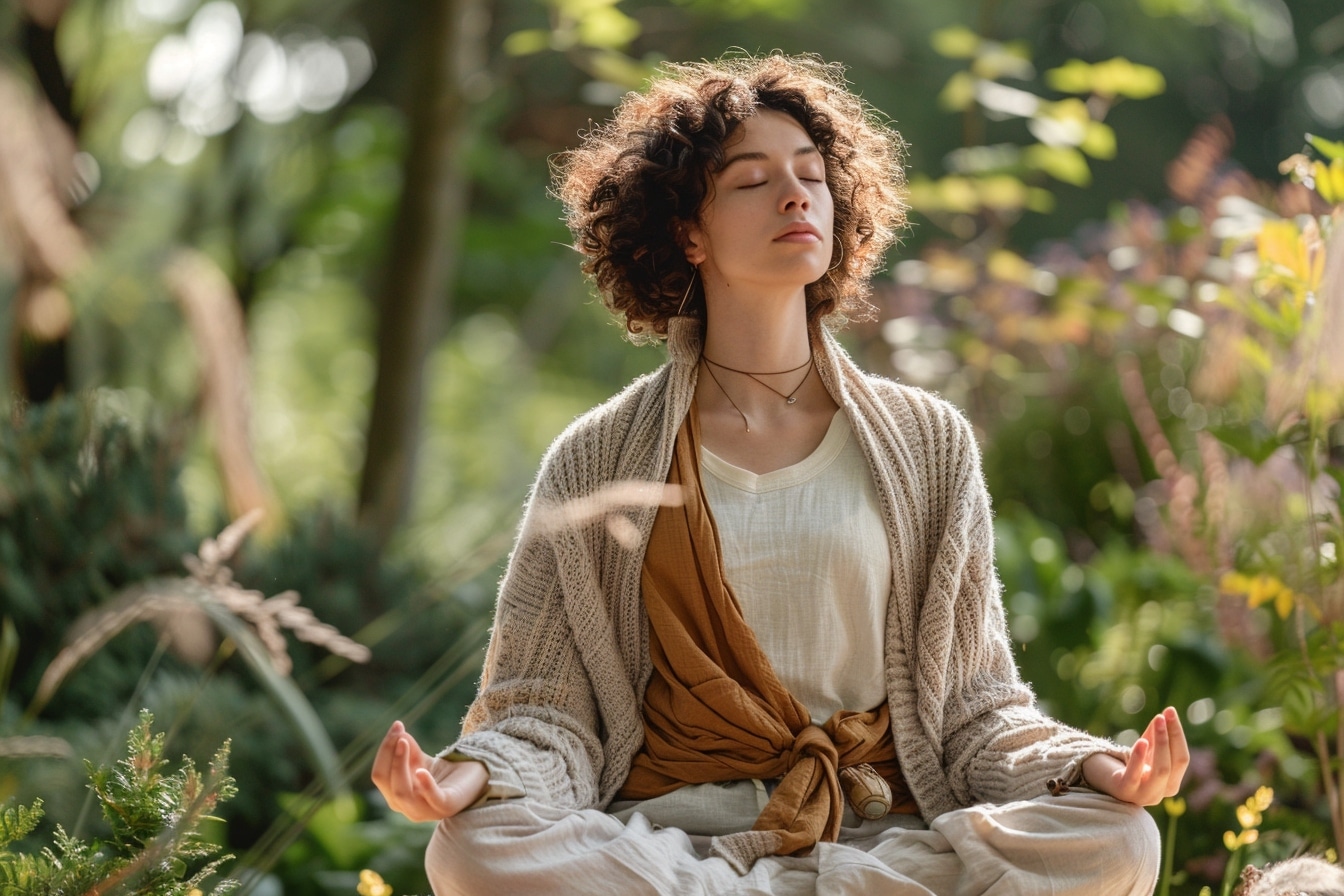Unlocking Body Wellness: The Power of Meditation in Releasing Physical Tension

Plunge into a soothing inner journey! Discover how meditation can be your ally in releasing physical tension and rediscovering mind-body harmony.
How to use meditation to release physical tension?

Everyday stress and tension can have a significant impact on our bodies. Meditation is an invaluable ally in soothing these physical ailments and regaining inner harmony. Here are a few tips for releasing bodily tension through the practice of meditation.
deep breathing to release tension
Deep breathing is one of the keys to releasing bodily tension. By taking the time to breathe consciously, inhaling deeply through the nose and exhaling slowly through the mouth, you allow your body to relax and release accumulated tension. Practice this conscious breathing for a few minutes every day to feel its benefits on your body and mind.
focus on your body’s sensations
When meditating, take time to focus on the physical sensations of your body. Close your eyes, observe the areas of tension and send them kindness and relaxation. Visualize these tensions gradually dissolving under the effect of your benevolent attention. This bodily awareness will enable you to release tension and deeply soothe your body.
using guided meditation for complete relaxation
Guided meditation is an excellent way to release bodily tension while being accompanied by a soothing voice. Choose a guided meditation session focused on body relaxation, following the voice’s guidance to release every part of your body. This guidance will help you relax deeply and release stored tension.
experience sound meditation to relieve tension
Sound meditation, based on listening to relaxing music or soothing sounds, is an effective method for releasing bodily tension. Make yourself comfortable, close your eyes and let yourself be carried away by the sound vibrations that deeply soothe your body. By incorporating these meditation tips into your daily routine, you’ll gradually release tension and regain a feeling of well-being and lightness. Take the time to take care of your body and mind with meditation, so you can live every moment to the full.
The benefits of meditation for physical well-being

Meditation is an age-old practice rooted in the quest for well-being and harmony. Its benefits for physical well-being are many and well-recognized. Here’s how meditation can help improve your physical health on a daily basis.
Deep relaxation to relax the body
Meditation, through concentration of the mind and breathing, induces a state of deep relaxation. By concentrating on the present moment and putting aside agitated thoughts, the body naturally relaxes. This deep relaxation helps reduce stress and muscular tension, improving blood circulation and overall body function.
Better pain management
By focusing on the breath and developing a heightened awareness of the body, meditation helps to better manage physical pain. Studies have shown that regular meditation practice can reduce pain perception and improve pain tolerance. This can be particularly beneficial for people suffering from chronic pain, such as backache or migraines.
Strengthening the immune system
As stress is a major factor in weakening the immune system, meditation, by acting to reduce it, helps to strengthen our natural defences. A study published in the journal Psychosomatic Medicine showed that regular meditation practice was associated with an increase in antibodies and an overall improvement in immune health.
Improving body posture and balance
As well as relaxing the muscles, meditation also helps to develop better body awareness. By focusing on body position, alignment and breathing, meditation can help improve posture and balance. Straighter posture and improved balance help prevent muscle pain and injury.
Stimulate physical recovery
By promoting a state of deep relaxation, meditation plays a key role in physical recovery. Whether after intense sporting activity or simply to allow the body to regenerate, meditation promotes better quality sleep and more efficient cell regeneration. In conclusion, meditation offers numerous benefits for physical well-being by promoting relaxation, helping to manage pain, boosting the immune system, improving posture and balance, and stimulating physical recovery. Incorporating meditation into your daily routine can be a valuable ally in achieving optimal physical health.
Meditation techniques to relieve muscular pain

Meditation is an age-old practice with proven benefits for our physical and mental well-being. Beyond relaxation, it can also be a valuable ally in relieving muscular aches and pains that may arise after a stressful day or intense physical activity.
1. Conscious breathing
Conscious breathing is a simple but effective meditation technique for relieving muscular tension. By concentrating on your breathing, you allow your body to relax and release areas of tension. Practice abdominal breathing by inhaling slowly through the nose, inflating the belly, then exhaling gently through the mouth, relaxing the muscles.
2. Body scan
Body scanning is a meditation method that involves mentally scanning each part of your body, becoming aware of physical sensations. By identifying areas of pain or muscular tension, you can gradually release them by visualizing them calming down. This technique allows you to deeply relax your muscles and improve blood circulation.
3. Guided visualization
Guided visualization is an approach to meditation that uses the imagination to soothe muscular pain. By imagining yourself in a calm, serene place, you can send soothing thoughts to your aching muscles. Visualize a flow of positive energy coursing through your body and releasing muscle tension, promoting natural pain relief.
4. Sound meditation
Sound meditation combines the benefits of meditation with the power of soothing sounds to relieve muscle pain. By listening to relaxing music, birdsong or specific sound vibrations, you can induce a state of deep relaxation. Sound vibrations can act directly on tense muscles, helping them to relax and ease pain.
5. The right meditation posture
Adopting a comfortable and appropriate meditation posture can also help relieve muscle pain. Use a cushion or meditation bench to maintain a relaxed sitting position and relieve pressure on the back and legs. By incorporating these meditation techniques into your daily routine, you can not only relieve muscular pain, but also improve your general well-being. Take the time to connect with your body and listen to its needs to find lasting, natural relief. Don’t hesitate to explore different approaches and adjust your practice according to how you feel, to optimize the benefits of meditation on your physical and emotional health.
Find serenity through meditation to relax the body
Meditation is an age-old practice that offers many benefits for body and mind. By focusing on the present moment and letting go of distracting thoughts, we can find deep inner serenity, which is also reflected in bodily relaxation.
the benefits of meditation for the body
Meditation releases the physical tensions accumulated over the course of the day. By focusing on the breath and adopting a comfortable posture, the body gradually relaxes. Muscles relax, breathing becomes calmer and the heartbeat slows down, promoting a deep sense of well-being. In addition, regular meditation practice promotes a better hormonal balance by reducing the production of the stress hormone cortisol, and increasing that of the happiness hormone serotonin. This helps reduce inflammation in the body and strengthens the immune system, enabling us to cope better with external aggression.
meditation techniques to relax the body
There are a number of meditation techniques specifically designed to relax the body. Sound meditation, for example, involves concentrating on soothing sounds, such as relaxing music or sound vibrations, which act directly on muscular tension and promote relaxation. Guided meditation sessions are also highly effective for relaxing the body. By following a guide’s instructions, you let yourself be carried along by his or her voice and indications to relax each part of the body, from head to toe, via shoulders, stomach and legs. The result is complete release and deep relaxation.
meditation accessories for optimum relaxation
To enhance the meditation experience and promote relaxation of the body, certain accessories can be used. An ergonomic meditation cushion helps to improve seating and maintain proper posture during the session. Finally, the use of essential oils with relaxing properties such as lavender, chamomile or peppermint can enhance the soothing effect of meditation on the body. A few drops on a handkerchief, diffuser or directly on the skin can help promote relaxation. In conclusion, meditation is a powerful tool for finding serenity and deeply relaxing the body. With regular practice and the right techniques, it’s possible to release physical tension and achieve a state of overall well-being.
Comments
Leave a comment